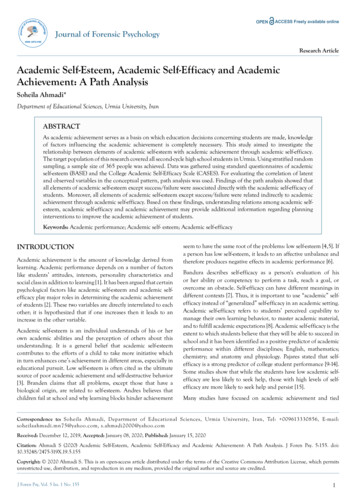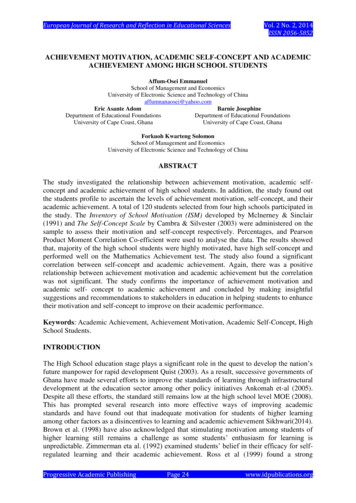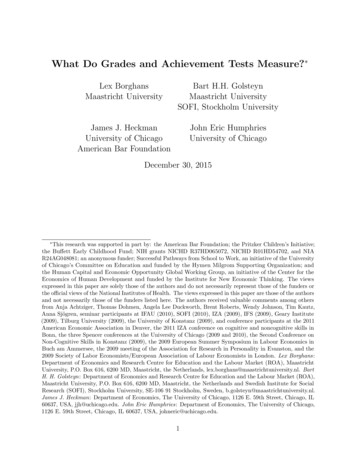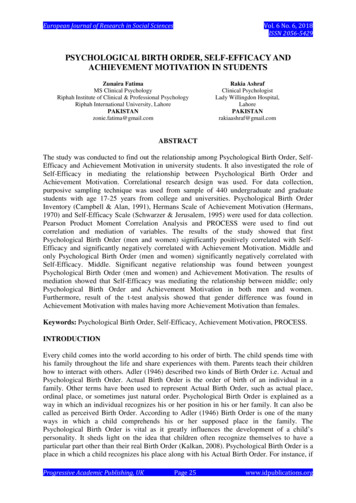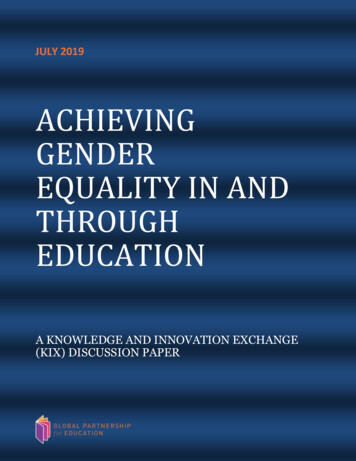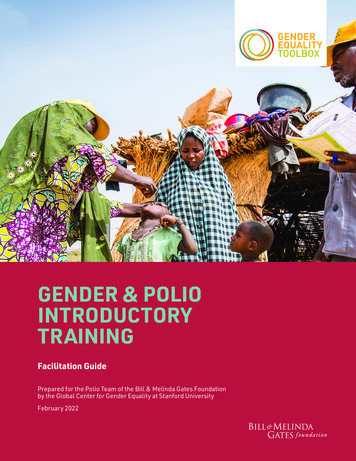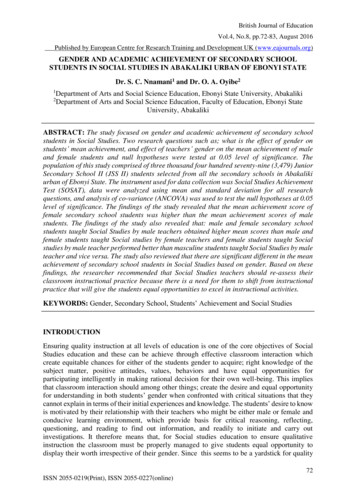
Transcription
British Journal of EducationVol.4, No.8, pp.72-83, August 2016Published by European Centre for Research Training and Development UK (www.eajournals.org)GENDER AND ACADEMIC ACHIEVEMENT OF SECONDARY SCHOOLSTUDENTS IN SOCIAL STUDIES IN ABAKALIKI URBAN OF EBONYI STATEDr. S. C. Nnamani1 and Dr. O. A. Oyibe21Department of Arts and Social Science Education, Ebonyi State University, AbakalikiDepartment of Arts and Social Science Education, Faculty of Education, Ebonyi StateUniversity, Abakaliki2ABSTRACT: The study focused on gender and academic achievement of secondary schoolstudents in Social Studies. Two research questions such as; what is the effect of gender onstudents’ mean achievement, and effect of teachers’ gender on the mean achievement of maleand female students and null hypotheses were tested at 0.05 level of significance. Thepopulation of this study comprised of three thousand four hundred seventy-nine (3,479) JuniorSecondary School II (JSS II) students selected from all the secondary schools in Abakalikiurban of Ebonyi State. The instrument used for data collection was Social Studies AchievementTest (SOSAT), data were analyzed using mean and standard deviation for all researchquestions, and analysis of co-variance (ANCOVA) was used to test the null hypotheses at 0.05level of significance. The findings of the study revealed that the mean achievement score offemale secondary school students was higher than the mean achievement scores of malestudents. The findings of the study also revealed that: male and female secondary schoolstudents taught Social Studies by male teachers obtained higher mean scores than male andfemale students taught Social studies by female teachers and female students taught Socialstudies by male teacher performed better than masculine students taught Social Studies by maleteacher and vice versa. The study also reviewed that there are significant different in the meanachievement of secondary school students in Social Studies based on gender. Based on thesefindings, the researcher recommended that Social Studies teachers should re-assess theirclassroom instructional practice because there is a need for them to shift from instructionalpractice that will give the students equal opportunities to excel in instructional activities.KEYWORDS: Gender, Secondary School, Students’ Achievement and Social StudiesINTRODUCTIONEnsuring quality instruction at all levels of education is one of the core objectives of SocialStudies education and these can be achieve through effective classroom interaction whichcreate equitable chances for either of the students gender to acquire; right knowledge of thesubject matter, positive attitudes, values, behaviors and have equal opportunities forparticipating intelligently in making rational decision for their own well-being. This impliesthat classroom interaction should among other things; create the desire and equal opportunityfor understanding in both students’ gender when confronted with critical situations that theycannot explain in terms of their initial experiences and knowledge. The students’ desire to knowis motivated by their relationship with their teachers who might be either male or female andconducive learning environment, which provide basis for critical reasoning, reflecting,questioning, and reading to find out information, and readily to initiate and carry outinvestigations. It therefore means that, for Social studies education to ensure qualitativeinstruction the classroom must be properly managed to give students equal opportunity todisplay their worth irrespective of their gender. Since this seems to be a yardstick for quality72ISSN 2055-0219(Print), ISSN 2055-0227(online)
British Journal of EducationVol.4, No.8, pp.72-83, August 2016Published by European Centre for Research Training and Development UK (www.eajournals.org)instruction that gives rise to increase in students’ achievement in classroom interaction, theissue of gender disparities in students’ achievement in Social Studies should be put inconsideration.Gender is a specially constructed phenomenon that is brought about as society ascribesdifferent roles, duties, behaviours, and mannerisms to the two sexes, (Mangvwat, 2006). It is asocial connotation that has sound psychological background, and it is used to refer to specificcultural patterns of behaviour that are attributed to human sexes. Gender relates to culturalattributes of both males and females (Akpochafo, 2009). Gender according to Lahey (2003) isa psychological experience of being a male or female. It has to do with personality and centralcomponents of self-concept. Unlike sex, which is concerned with, only the distinction betweenmale and female based on biological characteristics, gender encompasses other personalityattributes as roles, orientation and identity based on individual’s conceptualization of self. Forinstance, Singh (2010) opines that gender refers to a socio-cultural construct that connotes thedifferentiated roles and responsibilities of men and women in a particular society. Thisdefinition implies that gender determines the role, which one plays in relation to generalpolitical, cultural, social and economic system of the society. According to Betiku (2002),gender refers to all the characteristics of male and female, which a particular society hasdetermined and assigned each sex. Also, Onyeukwu (2000) sees gender as the dichotomy ofroles culturally imposed on the sexes.Avulata and Oniyama (1999) once described gender stereotype in school as “hiddencurriculum” which send out messages to girls to conform to role expectation. In most societies,gender has roles based on the women folk, preventing their participating in, and benefitingfrom development efforts (UNESCO, 2000). This has created a big psychological alienation ordepression in the minds of the female students (Joel and Aride, 2006). As a result, boysdominate Social Studies, Chemistry, Physics, Mathematics and Environmental studies classeswhile the girls go into reading languages and Arts.United Nations (UN) adopted various resolutions to ensure equal opportunities for all genderin education and empowerment. In 1982, UNESCO conference in Harare called for setting upof structures in Africa at the National level to develop, absorbs and uses Science andTechnology to distribute developmental tools among the various genders. Okeke (1997)affirmed that the proportion of girls in science classes in secondary and tertiary institutions orin employment as scientist, engineers, and technologists in Nigeria is quiet low. In line withthe above claim, Akpochafo (2009) reported that in Nigeria as in many African societies, thereis gender bias, a situation in which cultural beliefs and structural arrangement favour men overwomen. This can be witness in most of elective positions contestable by man and woman.People always see women as not fit to govern or rule since men are involved. The idea thatfemale should be under and submissive to men have created negative influence in the lifewomen folk. Explaining further, Anele (2008) is of the view that the socio-cultural practices ofthe African societies have placed men on the position, which give them domineering influenceon women folk. In an argument for, and attempt to debunk a belief that seems to general inAfrica to create a kind of relief for gender equality, Okoye (1987) argued that because ofvarious biological differences in human make-up such as those between male and female,people assume that one sex may have a learning edge over the other sex. Intrinsically, there ispractically no significant difference in the intelligence between male and female that can betraceable to gender difference. He argued that, the fact that men are regarded as the dominant73ISSN 2055-0219(Print), ISSN 2055-0227(online)
British Journal of EducationVol.4, No.8, pp.72-83, August 2016Published by European Centre for Research Training and Development UK (www.eajournals.org)and even superior sex does not mean that they are artistically better than women are, (Okoye,1987).Okeke (2007) equally observed that, the Nigerian school curriculum is not gender fair sinceits contents reflect mainly the concerns of males; science careers portray masculine images inthe curriculum; and more still, female suffer discrimination from teachers overtly & covertly,knowingly and unknowingly. These actions automatically put the girls in a disadvantagedposition for achievement in classroom interaction especially in Social Studies and sciencerelated subjects.Since post-independence era in many developing countries like ours (Nigeria), education hasbeen emphasized both as a basic right and as a major enabling factor for the developmentprocess. The launching of the Universal Basic Education (UBE) and the world declaration ofEducation for All (EFA), to which Nigeria is a signatory, underscores the importance ofeducation for all. There is a continual reminder that Nigeria is a signatory to variousdeclarations of human rights 1948, 1959, 1966, 1989 and 1999, all of which agree that, thechild irrespective of sex, has the right to good education, freedom from all forms ofdiscriminations and freedom to participate freely in any National development programme(Allele, 2000). In many Nigerian societies, people and even some educated ones still believethat women education end in her kitchen. They still have this hunches that by nature womenare created to continue the work of creation by God through child-bearing not to participate inany intelligent social action.Okoro (2008) thus observed that males and females show great differences in their interest andcareer choice. These differences may be attributed to the psychological differences and culturalinfluences. Females’ enrollment in vocations is quite different from those of males. Evenparents generally encourage their daughters to opt for professions not masculine in nature.UNESCO (2000) has it that local customs, values have been developing in girls, and they areso deeply ingrained that some of them find it difficult to cope in areas that are believed to bemale dominated professions. Lie and Syoberg (2004) observed that, invisible rules within thesociety have provided what is feminine and what is masculine. This could also be found inSocial Studies classroom interaction as male students dominate the female folk in all sorts ofcurricula activities.Achievement test results conducted by Onekutu (2002) has shown that boys and girls in theearly ages perform equally in all subjects including English language, and as they grow tohigher classes, the girls begin to get more interested in language Arts, while the boys take moreto sciences and Social Sciences. This has resulted to a situation where there are more boys thangirls offering Social Sciences. However, the issue of gender and students’ academicachievement has remained a controversial one. While some propose that, males perform betterthan females in academics, others argue that, the reverse is the case. Veinon (2002) reportedthat, many comparisons show average scores of boys and girls to be the same on generalintelligence test. He said that, girls do a little better on most verbal tests and on tests involvingrote memory than boys. On tests of inductive reasoning and arithmetical ability, though with agreat deal of overlapping, the average differences, he said, seldom exceeds about four pointsof intelligence quotient. He added that, the most marked difference occurs on spatial andmechanical tests, and wonders if such ability might be attributed to the cultural influences onour civilization, which encourages boys to develop physical, constructional and mechanicalinterests. He concluded that, many surveys demonstrate that the range or spread of ability isslightly more restricted in girls.74ISSN 2055-0219(Print), ISSN 2055-0227(online)
British Journal of EducationVol.4, No.8, pp.72-83, August 2016Published by European Centre for Research Training and Development UK (www.eajournals.org)Gessell (2004) asserted that girls under the age of fourteen years usually perform better inEnglish language than boys of the same age. In addition, after that age, the boys usuallyovertake the girls. The initial higher achievement by girls than boys, according to Okoye (2009)was as a result of girls over attachment to their mothers in household chores involving socialinteraction with their mothers and measuring out of food items, quantities of water and otherliquids, timing the period for which a particular food needs to boil on fire. In addition, cookinginvolves estimation of how much each person in the family needs and making allowance fornecessary wastages. All these are practical interactions of English language which girls areexposed to as they under-study their mothers, hence, their initial higher achievements asasserted by (Gersell, 2004).Denga (1998) posited that no evidence is clear as to whether differences exist between malesand females in academic achievement. He however stated that, girls tend to do better than boysin language Arts like English language and music while the boys tend to outperform the girlsin Mathematics and Sciences. In the same vein, Kelly (2005) pointed out that attempting torelate specific intellectual abilities to achievement in specific subject areas is prone toconsiderable problems. Gender differences in intellectual abilities can be as a result of genderrole stereotyping. Gender differences in academic performance cannot therefore be assumed tobe due to inherent biological differences between the genders even if they exist. The theory ofinnate gender differences in ability that might be used to account for gender differences inacademic performance has weak evidence. According to Kelly, in many psychological areas,it is virtual impossibility to separate completely the innate from the acquired.Gender is a strong predictor of human conduct and many differences have been documentedon attitude and behaviour that affect academic performance in between males and females,(Block, 2006). Academic performance differs between boys and girls in basic subjects likeSocial Studies both in primary and secondary levels. Calsmith (2007) explained that, theinfluence of gender and differences in academic performance is a complex task, thus manystudies appear to be contradictory. A tremendous amount of work has been done in an attemptto find out potential causes of differences between girls’ and boys’ academic performances inSocial Sciences and this has clearly demonstrated that male students are superior to their femalecounterparts in qualitative courses. Maccoby (2003) for example, pointed out that girls aremore conforming, suggestible and dependent on the opinions of others. The traits in turn havebeen related to dependency, inability to break a set of tasks. Maccoby then suggested that, thesesame traits in females might also account for their superior performance on tests involvinganalytic thinking, spatial and abilities.In western societies, females possess higher ability in verbal test English language than males.Sweeney, (2003) notes that female students are lower in mathematics and spatial ability, asmales were superior to females on problem solving tasks and on specific abilities related toproblem solving. Messies (2006) contended that there are gender differences in intellectualfunctioning that attempts to account for both mean differences and differences in correlationpatterns between the genders. He concluded that in the period of secondary school and beyond,the intellectual domain reveals few consistent differences between the genders. Husen in Ayayo(2007) indicated in an investigation spanning twelve industrialized countries the ability of bothmale and female students in their general academic performance. The result revealed that maleswere superior over females. This superiority was not confining to the United States of Americaalone. The findings also confirmed that, even with the level of instruction held constant, malesachieved higher levels than females. Ayayo (2007) attributed the differences in performance75ISSN 2055-0219(Print), ISSN 2055-0227(online)
British Journal of EducationVol.4, No.8, pp.72-83, August 2016Published by European Centre for Research Training and Development UK (www.eajournals.org)between boys and girls to the school environment and programmes. She opined that prior toattending school, general intelligence of girls was higher than that of boys but the positiongradually reversed with the findings.According to Douglas (2004), girls excelled in English language, especially in subjects that aretaught by men since the secondary schools where English language is taught, is highly afeminine teaching environment. Douglas stressed that, this is probably one explanation forgirls’ success at the primary and early secondary school years. Supporting this position, Powell(2004) held the opinion that girls do better at all levels than boys in achievement even in areassuch as language and arithmetic where boys seemed to excel, girls seem to have better grades.It is obvious from the related literature reviewed that the role of gender in the academicperformance of students is a controversial issue. This is because while some research findingsrevealed that gender plays active role in students’ academic performance, others revealedotherwise. This therefore leads to investigation of effect of gender on secondary schoolstudents’ academic achievement in Social Studies.Research Questions and HypothesesTwo research questions and two null hypotheses guided the researchers in the successfulconduct of this study.1. What is the effect of gender on main achievement of secondary school students in SocialStudies in Abakaliki Urban of Ebonyi State?2. What is the effect of Teachers’ gender on main achievement of secondary school studentsin Social Studies in Abakaliki Urban of Ebonyi State?Ho1: There is no significant main effect of gender on the meanschool students in Social Studies.Ho2:achievement of secondaryThere is no significant main effect of teachers’ gender on the mean achievement ofsecondary school students in Social Studies.METHODOLOGYThis study adopted quasi-experimental research design, involving a pre-test and post-test. Thedesign was suitable for the study because intact classes were used and were randomly assignedto both treatment and control groups. Intact classes were used because of the period the studylasted and it was not proper to disrupt normal classes. The design is represented thus;Ya X Yb-- -----------Ya x YbWhereYa PretestYb PosttestX Treatment x Control76ISSN 2055-0219(Print), ISSN 2055-0227(online)
British Journal of EducationVol.4, No.8, pp.72-83, August 2016Published by European Centre for Research Training and Development UK (www.eajournals.org)The population of this study comprised of three thousand four hundred seventy-nine (3,479)Junior Secondary School II (JSS II) students selected from all the secondary schools inAbakaliki urban, (Ebonyi State Universal Basic Education Board, 2015). JSS II classes wereused for the study because this is the class among which Social Studies is offered as a subject.The researchers decided not to use JSS I students since at that level of class, students were onlyexposed to introductory aspects of Social Studies which cannot contribute to the research athand and JSS III students were not also chosen because this category of class is purely anexamination class and so cannot be expose to rudiments of experimental research design. Theresearchers’ choice of JSS II students for this study stemmed from the fact that junior secondaryschool two students have been exposed to the basic processes and procedures of Social Studiesas a subject of instruction and was not examination classes. The simple random samplingtechnique was used to select three (3) secondary schools with the sample size of two hundredand five (205) junior secondary school two students in Abakaliki urban for this study. Out ofthese four schools, two schools were assigned to the experimental group while the remainingtwo schools were assigned to the control group using simple random sampling technique byballoting. In addition, out of two hundred and five (205) students, one hundred and six (106)were female students while ninety-nine (99) were male students. Ninety-four (94) male andfemale students were taught Social Studies by both male and female teachers in Abakaliki Highschools and out of the remaining one hundred and eleven (111) students, sixty-two (62)students were taught Social Studies by a male teacher separately in Urban Secondary School,Abakaliki while forty-nine (49) students were taught Social Studies by a female teacher in IzziHigh School, Ishieke-Abakaliki respectively.The instrument used for data collection in this study was Social Studies Achievement Test(SOSAT) constructed by the researchers with thirty-three (33) multiple-choice items withoption A-D to aid achievement of the purpose of the study. The SOSAT was made up of twomajor sections thus; Section A and Section B. Section A contained information on the personaldata of the respondents while Section B carried information on the Social Studies AchievementTest questions. At the beginning of the experiment ‘SOSAT’ was administered to both studentsin their respective schools as pre-test with the aid of the class teachers. At the end of the test,scores of the students on the pre-test were recorded and kept. The same instrument wasadministered to the students at the end of the experimental period. Later, the scores obtainedfrom the pre-test and post-test were subjected to both inferential and descriptive statisticalanalysis. Mean and standard deviation were used to answer to the research questions while theanalysis of co-variances (ANCOVA) was used to test the null hypotheses at an alpha level ofsignificance 0.05.RESULTSIn this section of the study, the results of data analysis were presented based on the two researchquestions and two null hypotheses that guided the conduct of this study.Research Question 1What is the effect of gender on main achievement of secondary school students in SocialStudies in Abakaliki Urban of Ebonyi State? The mean scores of all male and female studentsinvolved in study in three schools for pretest and posttest were used to answer the researchquestion. Summary of results of data analysis were presented in table 1.77ISSN 2055-0219(Print), ISSN 2055-0227(online)
British Journal of EducationVol.4, No.8, pp.72-83, August 2016Published by European Centre for Research Training and Development UK (www.eajournals.org)Table 1: Mean scores of male and female secondary school students taught ale73.05311.357106The results of data analysis presented in table 1 above revealed that gender seemed to havedifferential effect on female students. This is because female students had a mean score of73.053 and a standard deviation score of 11.357 while the male students had a mean score of71.218 and a standard deviation score of 9.575. This implies that female students perform betterthan the male students in Social Studies in the classroom interaction.Research Question 2What is the effect of Teachers’ gender on main achievement of secondary school students inSocial Studies in Abakaliki Urban of Ebonyi State? The mean scores of one hundred andeleven (111) male and female students involved in study in selected two schools for pretest andposttest were used to answer the research question. Summary of results of data analysis werepresented in table 2.Table 2: Mean scores of male and female secondary school students taught SocialStudies by male and female teachersStudentsMaleFemaleSocial Studies TeachersMale TeachersFemale Teachers75.25067.91576.58460.600In table 2, the results of data analysis revealed that gender had much differential effects onsecondary school students’ mean achievement in Social Studies taught by male teachers withthe mean scores of 75.250 and 76.584 compared to achievement of other secondary schoolstudents taught Social Studies by female teachers that had mean scores of 67.915 and 60.600.From the results of data analysis, in table 2 above the researchers observed that teachers genderinfluences the academic achievement of secondary school students in Social Studies. Forinstance, it could be observed in table 2 that female students taught Social Studies by maleteachers performed better with mean score of 76.584 than their male counterpart with meanscore 75.250 while male students taught Social Studies by female teachers performed betterwith mean score 67.915 compare to the performance of female students taught by femaleteachers with mean score of 60.600. These imply that both students’ and teachers’ gender haveeffects on secondary school students’ mean achievement in Social Studies in Abakaliki urbanof Ebonyi State.Testing of the Null Hypothesis 1Ho1: There is no significant main effect of gender on the meanschool students in Social Studies.achievement of secondary78ISSN 2055-0219(Print), ISSN 2055-0227(online)
British Journal of EducationVol.4, No.8, pp.72-83, August 2016Published by European Centre for Research Training and Development UK (www.eajournals.org)Table 3: Analysis of Co-variance for students’ mean achievement in Social StudiesSource ofSum Main Effects999.067Gender2029.1092-way 38Total12139.694Significant at P 0.05Df112114200204Mean .677Sig of F.000.000.000.000.032.000In the ANCOVA table, the result of hypothesis 1 presented in table 3 showed that the value ofF-sig (.000) is lower than the value of F-cal (41.606) at 0.05 level of significance; this indicatedthat hypothesis 1 is rejected. Therefore, there is a significant effect of gender on the meanachievement of secondary school students in Social Studies.Testing of the Null Hypothesis 2Ho2: There is no significant main effect of teachers’ gender on the mean achievement ofsecondary school students in Social Studies.Table 4: Analysis of Co-variance for students’ achievement based on Teachers’GenderSource ofSum 78Main Effects9.081Male2029.109Female8.6512-way Interactions60.388Male l16391.161Significant at P 0.05Df11211114106110Mean 06.2331.5551.55583.498Sig of F.000.000.980.000.847.216.216.000In the ANCOVA table, the summary of result of hypothesis 2 presented in table 4 showed thatthe value of F-cal (1.555) is greater than F-sig (0.216) at 0.05 alpha level significance, thisindicated that hypothesis 2 was rejected on the ground that the decision rule was to reject thenull hypothesis when the calculated value is greater than the significant value at 0.05 level ofsignificance. This implies that there were significant effects of teachers’ gender on meanachievement of secondary school students in Social Studies in Abakaliki urban of Ebonyi State.79ISSN 2055-0219(Print), ISSN 2055-0227(online)
British Journal of EducationVol.4, No.8, pp.72-83, August 2016Published by European Centre for Research Training and Development UK (www.eajournals.org)DISCUSSIONEffects of Gender on mean Achievement of Secondary School Students in Social StudiesThe findings of data analysis presented in table 1 above revealed that gender seemed to haveslight differential effect on male and female secondary school students mean achievementscores in Social Studies. This is because female students had a mean score of 73.053 and astandard deviation score of 11.357 while the male students had a mean score of 71.218 and astandard deviation score of 9.575.The summary of the findings of the test of significance of difference in the mean achievementscores of male and female students as presented in table 3 showed that the value of F-sig (.000)is lower than the value of F-cal (41.606) at 0.05 level of significance. This indicated that thenull hypothesis 1 was rejected on the ground that the value of F-sig (.000) is lower than thevalue of F-cal (41.606) at 0.05 level of significance. This implies that there was significantmain effect of gender on the mean achievement of secondary school students in Social Studiesin Abakaliki urban of Ebonyi State. The findings of this study disagreed with the finding ofOleabhiele (2011) who held that male students perform better than female students in anyclassroom instructional activities that involve calculation. Also, Ajaegbu (1999) observed thatfemale students perform better in languages and arts while male students perform better inMathematics and related Science subjects. This showed that gender wield greater effects onfemale students’ achievement in Social Studies here in Ebonyi State as observed most westernsocieties where females possess higher ability in verbal test English language than males.Sweeney, (2003) notes that female students are lower in mathematics and spatial ability, asmales were superior to females on problem solving tasks and on specific abilities related toproblem solving. Messies (2006) contended that there are gender differences in intellectualfunctioning that attempts to account for both mean differences and differences in correlationpatterns between the genders. He concluded that in the period of secondary school and beyond,the intellectual domain reveals few consistent differences between the genders. Husen in Ayayo(2007) indicated in an investigation spanning twelve industrialized countries the ability of bothmale and female students in their general academic performance.Effects of Teachers’ Gender on mean Achi
achievement of secondary school students in Social Studies based on gender. Based on these findings, the researcher recommended that Social Studies teachers should re-assess their classroom instructional practice because there is a need for them to shift from instructional practice that will give the students equal opportunities to excel in .
